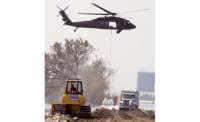...a crew shot a lead line across the opening and then used hydraulic winches to unfold and position a tube.
The dry weight of the device is about 3700 lb, Resio says. For the demonstration, it was about 70% filled, which means it weighed about 800,000 lb.
“That’s the type of force you have to stop when you are sealing a levee breach,” Resio says. ERDC would have liked to use 2,000-lb-tensil-strength-rated material, but that would have required a longer lead time. Still, the 100-ft-long tube has been used numerous times now. Resio says, “It is a fairly robust system.”
However, rips or tears may require debris scouts when deploying in real-life emergency situations, although the tubes can be repaired, Resio says.
DHS had a two-year plan to bring the technology to operational status for disaster response but has no money to do so, says William Laska, program manager for DHS’s science and technology directorate. “Unfortunately, this is the end of the funding today,” Laska said at the test.
Even without funding for further development of the tubes, ERDC plans to use its new facility—which boasts more water flow than any other research lab in the country—to test levee overtopping, deployment and anchoring of breach repair tubes and, possibly, to train future tube users, Wilson says.
A 1:8 scale demonstration of an arch-shaped tube was presented in a hangar. Once a breach is plugged, the arch can be placed to span beyond it to form a cofferdam for repairs, explained Jimmy Fowler, associate technical director of ERDC’s Coastal Hydraulics Lab. “We’re looking at other applications for arches, like using them in dam maintenance.”
Once water-resources contractors see the application possibilities, they will want to partner with the federal government to advance tube technology, predicts Randall Behm, the chief of flood risk and floodplain management in the Corps’ Omaha District.
“There are so many levees where we are constantly battling erosion, flooding and overtopping,” Behm says. “Many levees are getting very old, and we’re not even sure of the integrity of the systems. This will help contractors come in and repair rapidly.”




